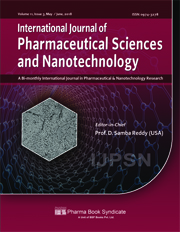Design and Preclinical Evaluation of Gastroretentive Floating Tablets of Quetiapine Fumerate
DOI:
https://doi.org/10.37285/ijpsn.2018.11.3.6Abstract
The present study was focused on gastro-retentive tablets of quetiapine fumarate using hydrophilic polymers HPMC K250 PH PRM, HPMC K750 PH PRM and HPMC K1500 PH PRM as release retarding agents. WSR 301 was chosen as resin, sodium bicarbonate was used as effervescent agents. FTIR studies revealed that there is no interaction between the drug and polymers used for the formulation. The tablets were prepared by direct compression method and the release rate was found to decrease with proportional increase in the ratio of polymer to drug. Quetiapine fumarate is absorbed well from stomach and therefore is a very good drug to be formulated into gastro retentive floating dosage form. In-vitro release profile of quetiapine fumarate and marketed product when compared, the optimized formulation F19 showed drug release of 98.65% within 24 h whereas 96.78% of the drug was released from the marketed product within 1h. The optimized formulation remained stable when subjected to accelerated stability studies. In vivo radiographic studies of quetiapine fumarate optimized formulation (F19) supported the expectations in prolonging the gastric residence time in the fasted state in beagle dogs. Cmax and AUC values of optimized formulation were found to be significantly higher than of marketed product. In conclusion, gastro-retention can be a promising approach to enhance bioavailability of quetiapine fumarate with narrow absorption window in upper GIT.
Downloads
Metrics
Keywords:
Quetiapine, Floating tablets, HPMC, Schizophrenia, Radiographic studies, BioavailabilityDownloads
Published
How to Cite
Issue
Section
References
Desai S and Bolton A (1993). Floating controlled release drug delivery system: In vitro–in vivo evaluation. Pharma. Res 10(9): 1321-1325.
Deshpande AA, Rhodes CT, and Shah NH (1996). Controlled release drug delivery systems for prolonged gastric residence: an overview. Drug Dev.Ind. Pharm 22: 531-539.
Grubel A (1987). Gastric emptying of non-digestible solids in the fasted dog. J Pharm Sci 76: 117-122.
Hwang S.K, Park H, and Park K (1998). Gastric retentive drug delivery systems. Crit. Rev. Ther. Drug Carrier Syst. 15: 243-284.
Kadivar A, Kamalidehghan B, Javar HA, Davoudi ET, Zaharuddin ND, Sabeti B, Chung LY, and Noordin MI (2015). Formulation and in vitro, in vivo evaluation of effervescent floating sustained-release imatinib mesylate tablet. PLoS One 10(6): e0126874
Lin S, Daggy BP, Mirchandani HL, and Chien TW (2002). Effect of formulation variables on the floating properties of gastric floating drug delivery system. Drug Dev Ind Pharm 28: 783-793.
Małgorzata W, Marcin Z, and Aleksandra A (2016). Tasting cetirizine-based microspheres with an electronic tongue. Sensors and Actuators B Chemical 238: 1190-1198.
Martindale – The Complete Drug Reference -35TH Edition; 766-779.
Mojaverian P H, Vlasses, P. E. Kellner and M. Rocci (1988). Effects of gender, posture and age on gastric residence time of an indigestible solid: pharmaceutical considerations. Pharm. Res 10: 639-644.
Nasrin N, Muhammad Asaduzzaman, Rumana Mowla, Farhana Rizwan, and Ashiqul Alam. (2008). A Comparative Study of Physical Parameters of Selected Ketorolac tromethamine tablets available in the Pharma Market of Bangladesh. Journal of Applied Pharmaceutical Science 1(8): 101-103.
Penners G, Lustig K, and Jorg PVG (1997). Inventors. Expandable pharmaceutical forms. US Patent 5651-985.
Phuapradit W (1989). Influence of Tablet Buoyancy on Oral Absorption of Sustained Release Acetaminophen Matrix Tablets [dissertation]. Jamaica, NY: St John’s University; 1989.
Phuapradit W and Bolton S (1991). Influence of tablet density on oral absorption of sustained release acetaminophen matrix tablets. Drug Dev Ind Pharm 17: 1097-1107.
Rama Rao T, Bala Krishna K, Mohammed Asif Hussain, Maimuna Anjum, and Mohd Azizurrahman (2014). Formulation and Evaluation of Gastroretentive Floating Tablets of Quetiapine Fumarate. RJPBCS 5(5): 975-985.
Singh K, Kumar A, Langyan N, and Ahuja M (2009). Evaluation of mimosa pudica seed mucilage as sustained-release excipient. AAPS Pharm Sci Tech 10: 1121-1127.
Tyagi LK, and Mohan Lal Kori (2014). Stability Study and In-vivo Evaluation of Lornoxicam Loaded Ethyl Cellulose Microspheres. International Journal of Pharmaceutical Sciences and Drug Research 6(1): 26-30.
Whitehead JT, Fell F and JH Collett (1996). Development of a Gastroretentive Dosage Form. European Journal of Pharmaceutical Sciences 4(1): 182.






